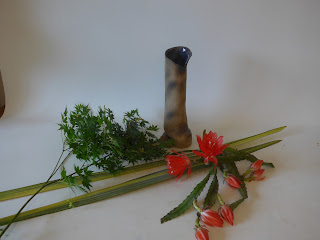Hello all,
Above is the photograph of a New Year arrangement I made for the last Ikebana International meeting for the year. I had, actually, prepared a much larger and more involved arrangement for this occasion, however, it would have been difficult to pack into the car and carry all the materials to the venue. So I quickly put together this simple arrangement using two of my favourite containers, sprayed strelitzia reginae leaves and 'Mr Lincoln' roses. For more photographs from our meeting please go II Melbourne.
Below is the original arrangement. The branch material is from the date palm after the fruit have fallen. The leaves were still attached, so I covered them with paper whilst praying the branches silver, then covered the branches whilst spraying the leaves gold. I used pine, ornithogalum and hippeastrum. The container is an asymmetric lacquered suiban, which Lucy brought back for me from Vietnam.
You may remember on a previous post that I mentioned the Box Hill Floral Art exhibition. My student, Nicole McDonald is a member of the group and took part in the 'Glass with Class' competition. I'm very proud to announce that she won first prize. Below is a photograph of her piece. She used weeping willow and strelitzia reginae.
And now for class.
Shaneen's piece, below, is of the theme 'Emphasizing Straight Lines' and she made it in her self made ceramic container
 |
| Bull rushes and green Goddess lilies |
 |
| Close-up of the container. . Shaneen used crushed glass in the depression but is not visible |
At a recent class I wanted to challenge the advanced students so I provided containers for each one that they had not used before and three different materials, at least one of which they had not used before. I, also, wanted to be challenged, so I asked Lucy to pick a container and materials for me to use.
 |
| Lucy chose Japanese maple, New Zealand flax and a succulent, the name of which I don't know. The container is one I made at the Sogetsu kiln |
 |
| This is how I arranged the quite disparate materials. And, yes it was challenging! |
 |
| Nicole used Japanese maple, spuria iris and aspidistra leaves in one of my self made containers |
 |
| Vicky used mahonia, spuria iris and euphorbia |
 |
| Bredenia used stripped fern, leaves and flower of what I think is curculigo and roses |
 |
| Lucy used gymea leaves, green Goddess lilies and yucca flower stem |
 |
| Strelitzia reginae and variegated agave |

Two views of the same arrangement.
I think it works well as an example of an
arrangement to be viewed from all sides
I made this next arrangement because I had a number of these Siberian iris flowers which are very short lived but which I love for their vivid blue colour. I used the citrus yellow container for contrast.
Bye for now,
Emily
















